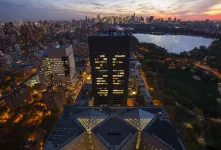(Press-News.org) Boston, Massachusetts, 12 November 2024 – The complex interplay between nitric oxide and brain disorders takes center stage in the latest Genomic Press Interview, published November 12, 2024, in Brain Medicine. Professor Haitham Amal, head of the Laboratory of Neuromics, Cell Signaling, and Translational Medicine at the Hebrew University of Jerusalem, shares insights into his groundbreaking research and personal motivation.
“Meeting families and children with autism in Boston during my time at MIT inspired me to focus on a single goal: to help develop biological diagnostics and treatment for autism spectrum disorder,” Professor Amal reveals. This pivotal experience shaped his research trajectory, leading to significant discoveries about the role of nitric oxide in neurological conditions. Prof. Amal was the first to discover that nitric oxide (NO) plays a pivotal role in autism.
The interview highlights Professor Amal's unique approach to understanding brain disorders, combining proteomics with systems biology. His research has uncovered crucial links between autism spectrum disorder (ASD) and Alzheimer's disease, suggesting shared molecular mechanisms that could revolutionize treatment approaches for both conditions.
“As a pharmacologist and neuroscientist, my unique expertise in understanding how drugs impact the brain is instrumental in achieving my goal of developing treatments for neurological disorders,” Professor Amal explains. His work has already led to the establishment of two biotechnology companies: Point6 Bio Ltd for ASD diagnostics and NeuroNOS Ltd for developing nitric oxide synthase inhibitors-based therapeutics for autism, Alzheimer’s disease and brain cancers.
The interview raises intriguing questions about the future of neurological treatment:
• Could targeting nitric oxide pathways provide a unified approach to treating both neurodevelopmental and neurodegenerative disorders?
• How might early biological diagnostics transform autism intervention strategies?
• What role will personalized medicine play in addressing individual variations in brain disorders?
Professor Amal's journey from studying cannabis effects on cognition to becoming a leading figure in neurological research demonstrates the unexpected paths that can lead to scientific breakthroughs. His commitment to conducting experiments on both sexes equally and interest in aging mechanisms suggests a comprehensive approach to brain research that could yield additional insights.
Currently on sabbatical at Harvard University, Professor Amal continues to push boundaries in neuroscience while mentoring the next generation of researchers. His work has garnered international recognition, including the prestigious Eagles Autism Foundation Research Grant, marking him as the first international scientist to receive this honor.
Professor Haitham Amal’s Genomic Press interview is part of a larger series that highlights the people behind today’s most influential scientific ideas. Each interview in the series offers a blend of cutting-edge research and personal reflections, providing readers with a comprehensive view of the scientists shaping the future. By combining a focus on professional achievements with personal insights, this interview style invites a richer narrative that both engages and educates readers. This format provides an ideal starting point for profiles that delve into the scientist’s impact on the field, while also touching on broader human themes. More information on the research leaders and research rising stars featured by Genomic Press can be found in our website: https://genomicpress.com.
The full Genomic Press Interview, titled “Haitham Amal: Nitric oxide is a shared molecular mechanism of multiple neurodevelopmental and neurodegenerative disorders” is available on 12 November 2024 in Brain Medicine, providing detailed insights into Dr. Amal’s research methodology and vision for the future of addiction neuroscience. The interview is freely available online at https://url.genomicpress.com/bdcrvkrw.
About Brain Medicine: Brain Medicine (ISSN: 2997-2639) is a peer-reviewed journal published by Genomic Press, New York. Brain Medicine is a new home for the cross-disciplinary pathway from innovation in fundamental neuroscience to translational initiatives in brain medicine. The journal’s scope includes the underlying science, causes, outcomes, treatments, and societal impact of brain disorders, across all clinical disciplines and their interface.
END
Autism and nitric oxide: Professor Haitham Amal unveils brain disorder breakthrough
Hebrew University neuroscientist shares personal journey and research vision in latest Genomic Press interview series
2024-11-12
ELSE PRESS RELEASES FROM THIS DATE:
Facing the wind: How trees behave across various forest settings and weather events
2024-11-12
Destructive winds during storms and cyclones often cause tree failures, especially through uprooting and stem breakage. However, how trees respond to wind under various forest configurations and weather conditions remains unclear. A recent study on Cryptomeria japonica plots shows that trees dissipate wind energy by switching between two swaying behaviors at specific wind speeds, offering insights that may help in improved forest management to minimize damage caused by storms.
Extreme weather events, such as tropical and extratropical cyclones and tornadoes, can cause widespread damage to forests, leading to environmental and financial ...
High-performance inkjet print head enhances bioprinting productivity
2024-11-12
Bioprinting is a technology used to create three-dimensional structures, such as human tissues or organs, using bio-inks made of cells and hydrogels. However, conventional inkjet technology has difficulty dispensing bio-inks that are sensitive to temperature due to the heat generated during operation. Furthermore, conventional 3D bioprinting mainly utilizes simple syringe-type printing devices with a single needle, making it time-consuming to produce artificial organs like the brain, lungs, and heart.
The Bionics Research Center team, led by Dr. Byung Chul Lee at the Korea Institute of Science and Technology (KIST, President Sang-Rok Oh), in ...
Opioid use disorder: Updated clinical practice guideline
2024-11-12
La version française suit
Opioid use disorder: updated clinical practice guideline
An updated evidence-based guideline aimed at helping clinicians and other health care providers manage patients with opioid use disorder recommends buprenorphine and methadone as first-line treatments. The guideline is published in CMAJ (Canadian Medical Association Journal). https://www.cmaj.ca/lookup/doi/10.1503/cmaj.241173
Opioid use and opioid use disorder are the leading causes of drug-related deaths worldwide, and Canada ...
Microneedle sensors for dermal interstitial fluid analysis
2024-11-12
The rapid advancement in personalized healthcare has driven the development of wearable biomedical devices for real-time biomarker monitoring and diagnosis. Traditional invasive blood-based diagnostics are painful and limited to sporadic health snapshots. To address these limitations, microneedle-based sensing platforms have emerged, utilizing interstitial fluid (ISF) as an alternative biofluid for continuous health monitoring in a minimally invasive and painless manner.
The team led by Wei Gao from California Institute of Technology providea a comprehensive overview of microneedle sensor technology, covering microneedle design, fabrication methods, ...
‘Sleepy cannabis’: first study to show cannabinol increases sleep
2024-11-12
Research by scientists at the University of Sydney has identified a constituent in the cannabis plant that improves sleep.
Their report is the first to use objective measures to show the component, known as cannabinol (CBN), increases sleep in rats.
The study has been published in the leading journal Neuropsychopharmacology.
“For decades, cannabis folklore has suggested that aged cannabis makes consumers sleepy via the build-up of CBN, however there was no convincing evidence for this,” said lead author on the study Professor Jonathon Arnold, ...
Mount Sinai team shows AI can detect serious neurologic changes in babies in the NICU using video data alone
2024-11-12
A team of clinicians, scientists, and engineers at Mount Sinai trained a deep learning pose-recognition algorithm on video feeds of infants in the neonatal intensive care unit (NICU) to accurately track their movements and identify key neurologic metrics.
Findings from this new artificial intelligence (AI)-based tool, published November 11 in Lancet’s eClinicalMedicine, could lead to a minimally invasive, scalable method for continuous neurologic monitoring in NICUs, providing critical real-time insights into infant health that have not been possible before.
Every year, more than 300,000 ...
Jeffrey Popma, MD, joins CRF as Chief Scientific and Strategic Officer
2024-11-11
NEW YORK – November 11, 2024 – The Cardiovascular Research Foundation® (CRF®) proudly announces the appointment of Dr. Jeffrey Popma as Chief Scientific and Strategic Officer. A world-renowned leader in cardiovascular research, Dr. Popma will drive forward pivotal programs and initiatives that will shape CRF’s future and fuel innovation at the CRF® Clinical Trials Center (CTC). His leadership will be instrumental in the development of the recently launched Real-World Data and Outcomes Center, advancing CRF’s commitment to impactful ...
Seiber elevated to IEEE senior member
2024-11-11
Larry Seiber, an R&D staff member in the Vehicle Power Electronics group at the Department of Energy’s Oak Ridge National Laboratory, has been elevated to senior member of the Institute of Electrical and Electronics Engineers, or IEEE.
Senior member status requires extensive experience that reflects professional accomplishments. Only 10% of IEEE’s more than 450,000 members achieve this level.
Seiber has conducted decades of cutting-edge research in power electronics and electric machinery. He developed the hardware ...
Study sheds light on how BRCA1 gene mutations fuel breast cancer
2024-11-11
People inherit two copies of each gene — one from each parent — an evolutionary fail-safe to ensure survival even when one of them doesn’t function.
For cancer-suppressor genes like BRCA1, researchers have long hypothesized that a single healthy copy could still guard against tumor development. Yet women with one harmful BRCA1 mutation are far more likely to develop breast cancer — a risk traditionally explained by a second mutation that arises later in life, damages the healthy copy of the gene, ...
A new wrinkle in turtles: Their genomes fold in a unique way, Iowa State researchers find
2024-11-11
AMES, Iowa – In their long strings of nucleotides, DNA molecules hold massive troves of genetic data providing instructions for how living organisms should function – the blueprint of life. How the blueprint is stored, however, impacts how it is read and used.
As cells divide and replicate, DNA strands coiled around proteins – chromatin – are in tightly bundled chromosomes. After division, the chromosomes loosen and chromatin is less compact. How and where the chromatin fiber folds and ...
LAST 30 PRESS RELEASES:
Exposure to natural light improves metabolic health
As we age, immune cells protect the spinal cord
New expert guidance urges caution before surgery for patients with treatment-resistant constipation
Solar hydrogen can now be produced efficiently without the scarce metal platinum
Sleeping in on weekends may help boost teens’ mental health
Study: Teens use cellphones for an hour a day at school
After more than two years of war, Palestinian children are hungry, denied education and “like the living dead”
The untold story of life with Prader-Willi syndrome - according to the siblings who live it
How the parasite that ‘gave up sex’ found more hosts – and why its victory won’t last
When is it time to jump? The boiling frog problem of AI use in physics education
Twitter data reveals partisan divide in understanding why pollen season's getting worse
AI is quick but risky for updating old software
Revolutionizing biosecurity: new multi-omics framework to transform invasive species management
From ancient herb to modern medicine: new review unveils the multi-targeted healing potential of Borago officinalis
Building a global scientific community: Biological Diversity Journal announces dual recruitment of Editorial Board and Youth Editorial Board members
Microbes that break down antibiotics help protect ecosystems under drug pollution
Smart biochar that remembers pollutants offers a new way to clean water and recycle biomass
Rice genes matter more than domestication in shaping plant microbiomes
Ticking time bomb: Some farmers report as many as 70 tick encounters over a 6-month period
Turning garden and crop waste into plastics
Scientists discover ‘platypus galaxies’ in the early universe
Seeing thyroid cancer in a new light: when AI meets label-free imaging in the operating room
Neutrophil-to-lymphocyte ratio may aid risk stratification in depressive disorder
2026 Seismological Society of America Annual Meeting
AI-powered ECG analysis offers promising path for early detection of chronic obstructive pulmonary disease, says Mount Sinai researchers
GIMM uncovers flaws in lab-grown heart cells and paves the way for improved treatments
Cracking the evolutionary code of sleep
Medications could help the aging brain cope with surgery, memory impairment
Back pain linked to worse sleep years later in men over 65, according to study
CDC urges ‘shared decision-making’ on some childhood vaccines; many unclear about what that means
[Press-News.org] Autism and nitric oxide: Professor Haitham Amal unveils brain disorder breakthroughHebrew University neuroscientist shares personal journey and research vision in latest Genomic Press interview series







